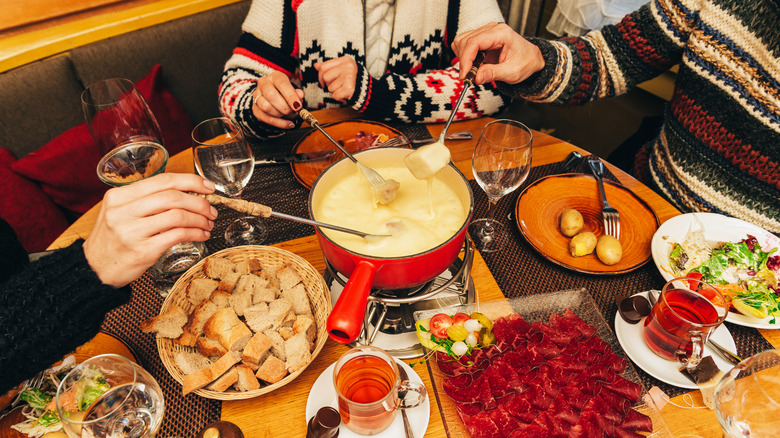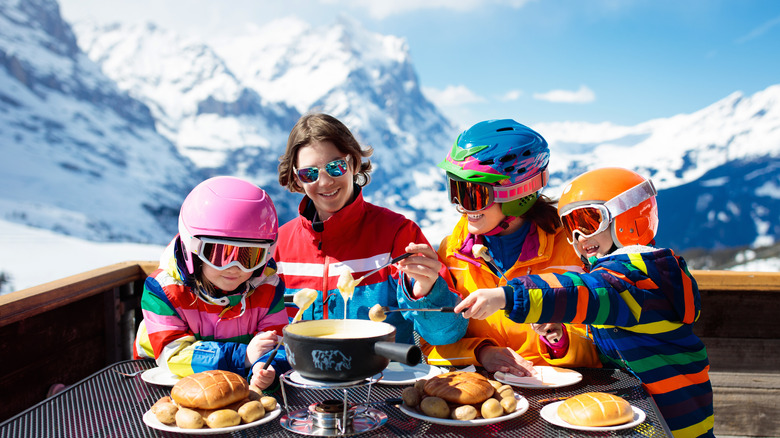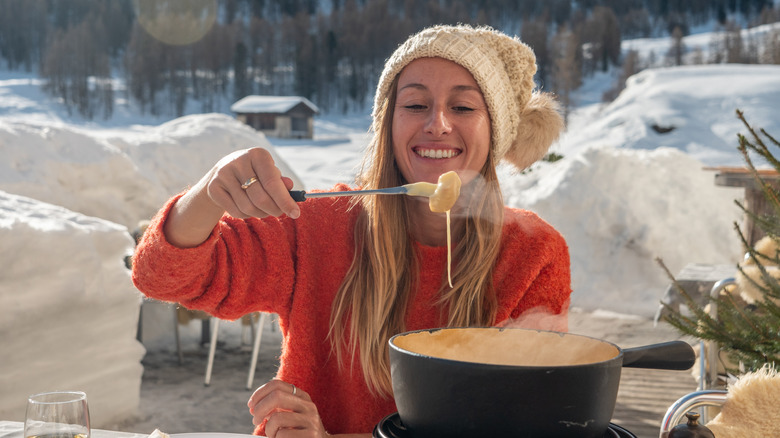For some people, fondue is a time machine back to the beige era of 1970s dinner parties, where the gooey cheese delight would often share table space with prawn cocktails, things trapped in aspic (meat jelly), and all manner of garish mousses and “surprises.” Much of that stuff would be inedible for a modern palate, but fondue has shed its kitschy reputation in recent years and become trendy again. Nowadays, you can pick up different fondue sets for any occasion, ranging from smaller units for intimate dunking to prestigious brass vats for large gatherings. In its native country, fondue never went away, and trying it out on its home turf is an essential part of your Switzerland trip. That said, there are some rules to follow if you want to enjoy the delicacy without making any silly mistakes.
The popularity of fondue at home and abroad is a combination of national pride, marketing, and deliciousness. Fondue started in the 18th century as a thrifty meal during the winter months combining cheese, wine, and stale bread for a warming shared meal. Over time, it became a national dish, boosted by the Swiss Cheese Union encouraging everyone to eat more cheese during the 1930s. Now, fondue is to the Swiss what fish and chips are to the Brits and Wiener Schnitzel is to the Austrians. So if you’re checking out fondue in Switzerland, what rookie mistakes should you avoid? To start, you better keep control of your bread and make sure it doesn’t fall into the fondue.
How to eat fondue like the Swiss … and the biggest mistake to avoid!

Whether you’re skiing in Switzerland or hiking the Alps in the warmer weather, the thing to note is that the Swiss don’t eat fondue all the time. It’s more of a winter dish, and they leave sweating over a pot of melted cheese in the summer months to the tourists. Fondue is usually made from a blend of cheeses, most commonly a “moitiè-moitiè” (half-half) of Gruyère and one other type. Added to the mix are ingredients like wine and garlic, sometimes punched up with additional herbs and spices. For dipping, bread is the standard, but potatoes, veggies, and pickled onions are also popular. The Swiss will often wash it down with a glass of white wine, kirsch, or herbal tea; it is a common belief that any other beverage will cause the cheese to congeal and give you chronic indigestion.
There are several rituals and customs associated with sharing a fondue set with fellow diners. Perhaps the gravest (and potentially costly) is making sure that you exercise control over your bread. Dropping your chunk in the mix is a big no-no and is punishable by a range of forfeits. If you’re dining in somebody’s home, you might get stuck with washing up duty. If it happens in a restaurant, you could get stung for a round of drinks or, worse still, the whole bill. Another playful forfeit is for any two people who lose their bread to kiss each other.
Other Swiss fondue traditions and faux pas

There are some other traditions to observe while you’re at the fondue pot. While dunking, it is customary to stir clockwise or swirl in a figure-eight pattern and never counterclockwise. From a hygiene perspective, it’s bad form to share fondue with people while you’re sick and to put your mouth all over your fork. The utensil will be going back in the cheese on numerous occasions, and your fellow diners won’t appreciate you slobbering all over it. Either delicately pluck the cube of cheese-coated bread from the fork with your teeth, or transfer it to a plate and then eat it. For similar reasons, dipping the same piece of bread more than once is strongly frowned upon.
The final ritual comes when all the melted cheese has been scooped up and tucked away. Rather than mopping up the last drops with bread, it is traditional to let the heat cook it into a crispy layer on the bottom of the pot. This is known as la religieuse (translated as “the nun”). The correct way to end the meal is to chip away at it and share the crusty delicacy with everyone at the table — washed down with another glass of kirsch, naturally! For dessert, chocolate fondue isn’t the answer. It is fairly rare in Switzerland, and the Swiss prefer to brighten up their palates after all that cheese with fresh fruit.

